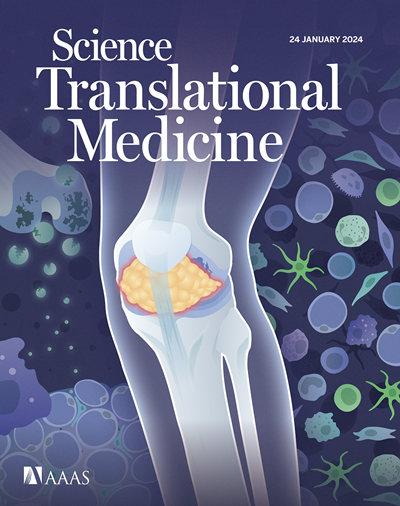Mechanical ventilation guided by driving pressure optimizes local pulmonary biomechanics in an ovine model
IF 14.6
1区 医学
Q1 CELL BIOLOGY
引用次数: 0
Abstract
Mechanical ventilation exposes the lung to injurious stresses and strains that can negatively affect clinical outcomes in acute respiratory distress syndrome or cause pulmonary complications after general anesthesia. Excess global lung strain, estimated as increased respiratory system driving pressure, is associated with mortality related to mechanical ventilation. The role of small-dimension biomechanical factors underlying this association and their spatial heterogeneity within the lung are currently unknown. Using four-dimensional computed tomography with a voxel resolution of 2.4 cubic millimeters and a multiresolution convolutional neural network for whole-lung image segmentation, we dynamically measured voxel-wise lung inflation and tidal parenchymal strains. Healthy or injured ovine lungs were evaluated as the mechanical ventilation positive end-expiratory pressure (PEEP) was titrated from 20 to 2 centimeters of water. The PEEP of minimal driving pressure (PEEPDP) optimized local lung biomechanics. We observed a greater rate of change in nonaerated lung mass with respect to PEEP below PEEPDP compared with PEEP values above this threshold. PEEPDP similarly characterized a breaking point in the relationships between PEEP and SD of local tidal parenchymal strain, the 95th percentile of local strains, and the magnitude of tidal overdistension. These findings advance the understanding of lung collapse, tidal overdistension, and strain heterogeneity as local triggers of ventilator-induced lung injury in large-animal lungs similar to those of humans and could inform the clinical management of mechanical ventilation to improve local lung biomechanics.
在绵羊模型中,由驱动压力引导的机械通气优化了局部肺生物力学。
机械通气会使肺部承受有害的压力和应变,从而对急性呼吸窘迫综合征的临床效果产生负面影响,或导致全身麻醉后的肺部并发症。根据呼吸系统驱动压力的增加估算,过大的整体肺应变与机械通气相关的死亡率有关。目前尚不清楚导致这种关联的小尺寸生物力学因素的作用及其在肺内的空间异质性。我们使用体素分辨率为 2.4 立方毫米的四维计算机断层扫描和用于全肺图像分割的多分辨率卷积神经网络,动态测量了体素范围内的肺充气和潮气实质应变。当机械通气呼气末正压(PEEP)从 20 厘米水滴调节到 2 厘米水滴时,我们对健康或受伤的绵羊肺进行了评估。最小驱动压力 PEEP(PEEPDP)优化了局部肺部生物力学。我们观察到,与高于 PEEPDP 的 PEEP 值相比,低于 PEEPDP 的 PEEP 值的非通气肺质量变化率更大。PEEPDP 同样也是 PEEP 与局部潮气实质应变 SD 值、局部应变第 95 百分位数和潮气过张程度之间关系的突破点。这些发现加深了人们对肺塌陷、潮气过张力和应变异质性作为呼吸机诱发肺损伤的局部触发因素的理解,这些因素在大动物肺中与人类肺相似,可为临床机械通气管理提供信息,以改善局部肺生物力学。
本文章由计算机程序翻译,如有差异,请以英文原文为准。
求助全文
约1分钟内获得全文
求助全文
来源期刊

Science Translational Medicine
CELL BIOLOGY-MEDICINE, RESEARCH & EXPERIMENTAL
CiteScore
26.70
自引率
1.20%
发文量
309
审稿时长
1.7 months
期刊介绍:
Science Translational Medicine is an online journal that focuses on publishing research at the intersection of science, engineering, and medicine. The goal of the journal is to promote human health by providing a platform for researchers from various disciplines to communicate their latest advancements in biomedical, translational, and clinical research.
The journal aims to address the slow translation of scientific knowledge into effective treatments and health measures. It publishes articles that fill the knowledge gaps between preclinical research and medical applications, with a focus on accelerating the translation of knowledge into new ways of preventing, diagnosing, and treating human diseases.
The scope of Science Translational Medicine includes various areas such as cardiovascular disease, immunology/vaccines, metabolism/diabetes/obesity, neuroscience/neurology/psychiatry, cancer, infectious diseases, policy, behavior, bioengineering, chemical genomics/drug discovery, imaging, applied physical sciences, medical nanotechnology, drug delivery, biomarkers, gene therapy/regenerative medicine, toxicology and pharmacokinetics, data mining, cell culture, animal and human studies, medical informatics, and other interdisciplinary approaches to medicine.
The target audience of the journal includes researchers and management in academia, government, and the biotechnology and pharmaceutical industries. It is also relevant to physician scientists, regulators, policy makers, investors, business developers, and funding agencies.
 求助内容:
求助内容: 应助结果提醒方式:
应助结果提醒方式:


